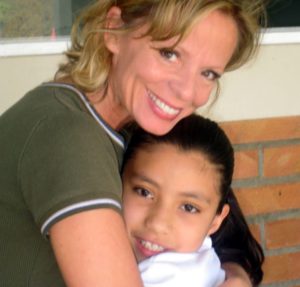I hate name tags. I’ll put one on at an event if I must, though if I do, it will eventually, accidentally on purpose fall off (faulty adhesive or . . . whatever). While I typically am pretty good at understanding why I feel a certain way, I don’t know why I loathe the tag. Maybe it feels like I’m walking around with a packaging label.
I do see the point, though. Especially when I’m at a function where I should remember someone’s name and I do not. It’s super helpful to be able to glance at that tag so as to avoid any awkward, “Heyyyyyy . . . how you doin’?” I like it when other people have name tags, for sure. That part works for me.
My mom only has the three of us kids—Cheryl, Danny, and me—but she almost never calls us by the correct name. This has been the case for long as I can remember, so it’s not a “getting older” thing. At age eighty-nine, she’s still sharp as a safety pin. But our names? Always a hangup. Most times she’ll string every name together until she gets to mine, if she ever does. And I always answer to any of the names, including my dad’s. I can just tell by her intonation when she means me. I don’t know how else to explain it. From the other room, I’ll hear her call, “Joe Cheryl Danny Pam . . .” Or sometimes it’s just one of the names, like my dad’s: “Joe!”
“Yes, Mom?”
I’m getting ready to take my yearly Guatemala trip where I’ll go visit well over one hundred little girls, each having what feels like a hundred names. I’ve been making this pilgrimage at least once a year since 2008, and so I’ve seen many girls progress from kindergarten to graduation. I know lots of first names, and because I keep track of who’s in school by their individual student ID, I’ll sometimes see someone’s three-digit number and their sweet face will flash in my mind as I’m doing my online IMA computer work here in the States.
On my first trip to IMA ten years ago, I couldn’t sleep. Everyone else was napping at the missionary house just beyond one of the campus’s walls, and although I tried, “nap” wasn’t happening. Our red-eye flight from southern California had landed in Guatemala City before sunrise, and all of my fellow travelers (who’d done this before) were trying to catch up on the sleep they’d missed. I was the rookie.
Fueled by either adrenaline or the TACA Airlines coffee, I was so amped about visiting the girls that I had walked the few steps over to the school in the early afternoon, entered the cafeteria through the back door, and peeked out the glass window to the courtyard playground, which is surrounded by classrooms. The only student I saw, however, was a lone girl walking from the restroom back to her class. Deflated, I figured I’d have to wait until recess.
I returned to the missionary house and unpacked. Then I walked back over to the cafeteria and checked the courtyard for signs of life. Still nothing. Back in my room though, right about half past three, I heard the distinct sounds of children’s laughter over the towering cinder-block wall. There were shrieks of joy; the ping of playground equipment, of recess time!
I bolted through the cafeteria and to the window, where I saw a sea of uniforms through a thin layer of playground dust. These were the IMA girls I’d heard so much about for so many years! As I slowly opened the glass door to step out into the playground, it seemed every student’s head—every head that only a moment before was busy playing—stopped, turned, and looked to see who was there.
In an instant, hundreds of beautiful brown eyes were on me. And then, as though there was a unified, silent decision to swarm me, I was engulfed by little girls in crisp blue and red and white uniforms. With pleading, love-filled eyes, they embraced me, grabbed my hands, and wanted to know me.
So this is the IMA love I’ve been hearing about.
I sank to my haunches to meet them at eye level and try to communicate with them. Quickly frustrated, I couldn’t understand a word—and this after months of Rosetta Stone Spanish. Then it occurred to me; I was hearing one sentence over and over again: “Como se llama?” I knew this question! Rosetta did not fail me!
I shot back: “My name is Pam!”
I heard giggles, “Bam?” They seemed confused and yet entertained by this strange American name. “Bam?”
I enunciated. “No, not Bam. Pam. Pppp. Pppp. Pam.”
A chorus of “Bam?” continued. I gave up and decided to ask them their names.
I heard willing shouts of “Maria,” “Lesli,” “Angelica,” “Joselin,” “Lourdes,” “Gabriela”—so many that I wished they had name tags to help me remember. Finally, I noticed a student standing demurely, silently sandwiched between the others and me, holding tightly onto my arm. Our eyes connected and I inquired, “Como se llama?”
She whispered, “Pamela.”
I wasn’t sure I’d heard her right. “Pamela? Your name is Pamela?”
She nodded rapidly, anticipating.
I yelped, “My name is Pamela!”
Her eyes widened. She seemed about to burst.
We embraced dramatically as though we were long-lost cousins who hadn’t seen one another in years. Meanwhile, it registered with the rest of the girls that my name was indeed Pamela, and for some reason, so much easier to say than Pam.
We all laughed together at this beautiful start to what would be a profoundly moving week together at the IMA School—and years of ongoing friendship with little girls whose names I would come to know by heart.
After recess I checked the student roster, looking to see if Pamela was sponsored. She wasn’t. Before school was over that day, I found her again and, with the aid of a translator, asked Pamela if she’d be okay with me sponsoring her. Her big, beautiful eyes smiling, she quickly nodded and melted into me. We were destined to be.
That moment is etched on my heart, as are my Guatemala girls.
They are not a student ID number. I’m not a number either. Thankfully, the God we share doesn’t need to glance down and look at our name tags. He knows each of us by name.

